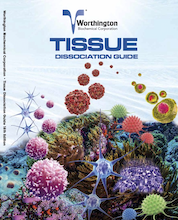For our international customers, please be advised that orders cannot be placed through our website by customers in countries with International Distributor representation.
Worthington Tissue Dissociation Guide
Dissociating Enzymes: Neutral Protease (Dispase)
Neutral Protease (Dispase) is a bacterial enzyme produced by Bacillus polymyxa that hydrolyses N-terminal peptide bonds of non-polar amino acid residues and is classified as an amino-endopeptidase. Its mild proteolytic action makes the enzyme especially useful for the isolation of primary and secondary (subcultivation) cells since it maintains cell membrane integrity.
Neutral Protease (Dispase) is also frequently used as a secondary enzyme in conjunction with collagenase and/or other proteases in many primary cell isolation and tissue dissociation applications. Neutral Protease (Dispase) dissociates fibroblast-like cells more efficiently than epithelial-like cells so it has also been used for differential isolation and culture applications. Other advantages are its non-mammalian (bacterial) source and its ability to be inhibited by EDTA.
Tissue Tables
The Worthington Tissue Tables provide references useful to researchers interested in tissue dissociation and cell harvesting procedures. The references are organized by Tissue and Species type and linked to PubMed citations. The Cell type, Enzymes, and Medium for each reference is provided.
To search by specific criteria, use the Tissue References Search Tool.
